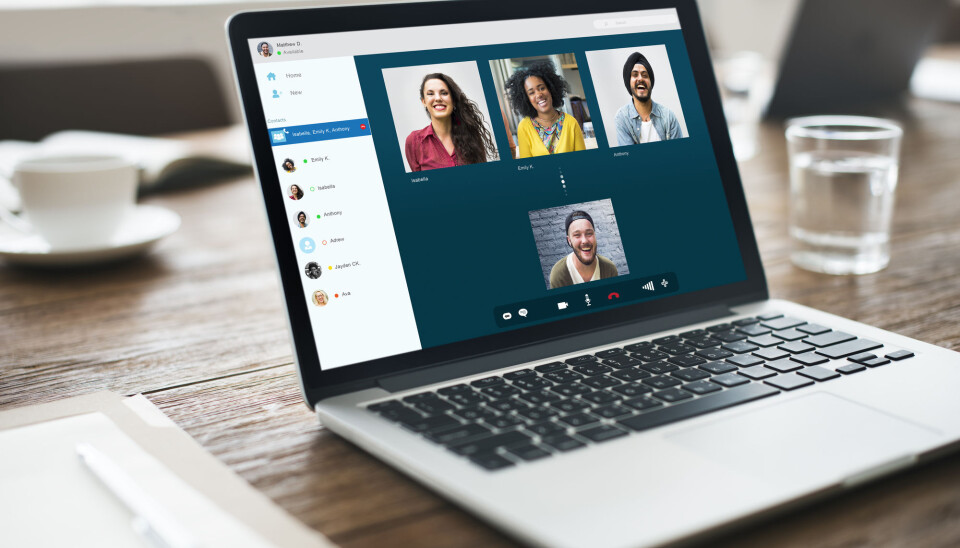This article was produced and financed by BI Norwegian Business School - read more

Life after corona and the rapid digitisation of human experiences
The current situation with the coronavirus is having an impact on almost every aspect of our everyday lives, including something particularly intriguing: the acceleration toward digital experiences.
“In light of measures like physical distancing and national lockdowns, many of us are now moving various aspects of our lives to digital environments, much faster than we even thought possible”, says Assistant Professor Carlos Velasco from BI Norwegian Business School.
He and his colleague Professor Marianna Obrist from the University of Sussex has looked at how the speed of digitisation has moved our work life online, how some of us are eating remotely or even partying more often digitally.
“More intriguingly, perhaps, is the fact that even experiences that we initially viewed as being far from digitisation, such us mourning a loved one, dinner parties, tourism or work conferences, are now taking place in digital environments, and sometimes even including augmented and virtual reality”, says Obrist.
But what does this accelerated change of human experiences mean for a time beyond the coronavirus? What will it mean for the development of future technology? How can we start reimagining human experiences in the context of an accelerated digital human-technology integration?

Participate in Carlos’ and Marianna’s quick Menti survey: See what others are doing online these days, and share three words describing your online life right now
From offline to digital realities
“Since the advent of digital technologies, we have witnessed an increase in the digitisation of human experiences. We have moved from purely offline and real experiences to a sort of mixed reality where both offline and digital worlds merge seamlessly in our everyday lives”, Velasco explains.
It is now common for many of us to have a smartphone, computer or tablet with us and to use it in multiple everyday life activities. Everything from navigating a city (Google Maps), through finding businesses (Yelp), to stargazing (SkyView), are now facilitated and augmented with digital technology.
“It has become common for many to connect and share experiences via social media, to interact with others remotely, and to use the internet to better understand, and interact with, the world around us”, Obrist adds.
Changing the balance from real to mixed reality
“Importantly, though, the process of digitisation of human experiences has been, in recent years, only in its early stages. However, the pandemic appears to be changing the game entirely. Even if it does not always ‘feel’ perfectly right, many of us are now studying, working, dancing, partying, enjoying art, travelling, and much more, from our homes via digital interfaces”, says Velasco.
The planned digitalisation of many businesses, education institutions and non-profit organisations has been accelerated. The same process that was going to take place in months or even years is now happening in a matter of weeks.
“This represents an interesting paradigm shift. The current pandemic is removing barriers associated with the habitual use of digital technologies”, says Obrist.
“Many of us have been reluctant to do certain things online, perhaps because of the lack of sensory cues (it does not feel as ‘real’) that are often present in offline situations, but the current situation demonstrates that, even if it feels different, it is possible, and it will happen”, Velasco comments.

This acceleration may however also leave many businesses, individuals and communities behind who are not ready for a digital transition. While the service industry will manage the transition and cope for the time being, the same does not necessarily apply to others, such as the construction industry.
“We see increased advances in robotics research and remote 3D printing technologies developed for challenging tasks, including space exploration. While this could make a difference in the future and transform the construction industry, the technologies are not fully ready to be deployed, at least not in the same accelerated form as we see in other aspects of our lives”, Obrist explains.
What’s next?
“Eventually, digital technologies will transform our human experiences, but what lasting effects will come from the accelerated digitisation? That remains to be seen, but we do know that upcoming technologies will allow us to integrate technology into our lives in an even more seamless manner and we will see an increased human-computer symbiosis”, says Velasco.
Indeed, researchers are making important advances in line with the digitisation of human experiences involving the human senses (sight, hearing, touch, taste, smell, and taste, among others), that is, the means through which we acquire information about the world around us.
“Perhaps unsurprisingly, several initiatives in the field of human-computer interaction (HCI) have already focused on developing novel devices, interfaces and systems that aim to facilitate remote dining, digital taste and smell experiences, and much more”, Obrist comments.
“In the future, we will not only see and hear in digital environments, but also touch, taste and smell. In fact, the possibilities are endless”, she says.
With the lack of real-world sensory inputs being one of the key problems of digital environments, HCI researchers are working towards developing novel sensory-enabling technologies that emulate the real world, (e.g. simulated walks on Mars). They are also working to create even more hyperreal experiences (that is, experiences that would not be possible otherwise in the real world), such as experiencing dark matter through different senses.
“Looking even further into the future, the digitisation of human experiences is not only about using technology, but also integrating it in us, our bodies, in order to augment our human experiences”, says Velasco.
The danger of ‘programmable’ human experiences
Considering all this, including the digital acceleration we are seeing right now, it is worth reflecting on their effects and implications.
“For starters, the same concerns we are debating more and more in public spheres, also apply here. These include privacy, security, universal vs. exclusive access to technology, increased predictability, and controllability”, says Obrist.
“The fact that experiences are more digitised also mean that they can, in a way, be ‘programmed’”, Velasco adds.
Although people are active participants in the creation of experiences rather than passive receivers of digital inputs, being able to program digital environments and interactions means more controllability of what we are exposed to and the consequences of how we behave in these environments.
“Hence, we believe, that it is important to make sure we all know who is behind digital experiences, their target audience and what rationale is used to deliver a given experience, be it through audio-visual or other sensory information. Transparency will become more important than ever”, Velasco and Obrist explain.
“All in all, it is reasonable to assert that we are witnessing an accelerated digitisation of human experiences. We are yet to understand its long-term impacts on our society as a whole. In the meantime, we need to prepare for a brave (and rapidly more digitised) new world”.
References:
Petit, O., Velasco, C., & Spence, C. (2019). Digital sensory marketing: Integrating new technologies into multisensory online experience. Journal of Interactive Marketing, 45, 42-61.
Velasco, C., Obrist, M., Petit, O., & Spence, C. (2018). Multisensory technology for flavor augmentation: A mini review. Frontiers in Psychology, 9:26.



































